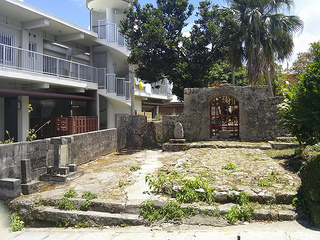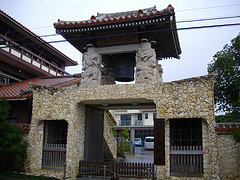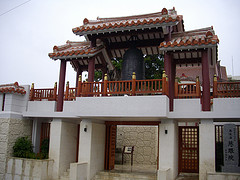Shuri




- Japanese/Okinawan: 首里 (Shuri / Sui)
Shuri was the royal capital of the Ryûkyû Kingdom, and of its predecessor, the kingdom of Chûzan. It was absorbed in the modern period into the neighboring port city of Naha, and is thus today a neighborhood of the prefectural capital of Okinawa.
During the time of the kingdom, the city was home to one of Ryûkyû's four groups of scholar-aristocrat lineages; the other three derived from Naha, Kumemura, and Tomari.
Geography & Sites
The royal palace, Shuri castle, faced west towards China. A major boulevard called Aijô-ufumichi (J: Ayamon ômichi) extended west from the castle's main gate, the Shureimon; this boulevard was home to a number of significant sites, many of which have been restored today. These include the Chûzanmon (second gate after the Shureimon); Nakagusuku udun, the Crown Prince's mansion; the royal mausoleum, Tamaudun; the Buddhist temples Ankokuzen-ji and Jigen-in; and the Uchakuya, an office/residence used by the zaiban bugyô, a representative of Satsuma han.[1] The grounds of the castle, along with Sonohyan utaki (a sacred site at the castle), Shikinaen, and Tamaudun, were named UNESCO World Heritage Sites in 2000, as part of a group called "Gusuku Sites and Related Properties of the Kingdom of Ryukyu."
King Shô Shin constructed a cobblestone road network known as Pearl Road (shinju michi) in 1522, connecting Shuri and a series of fortresses built to defend the city. One section of that road, known as the Shuri Kinjô stone-paved road, survives today a short distance south of the castle.[2]
A large marketplace, called ufumachi (大市), once stood just outside the castle grounds - north of the Shureimon and west of the Ryûtan pond. This was the chief marketplace in Shuri, providing food and other goods to the residents. The location is today the site of Jôsei Elementary School.[3] It was neighbored by a royal horse-riding grounds, the Matsuzaki baba, and by the Nakagusuku udun, the Crown Prince's mansion, which was moved from Aijô-ufumichi to that location, north of the Ryûtan, in 1875. The Okinawa Prefectural Museum was later built on that site, but there are now plans to restore the mansion, as a culture & community center, by 2020. The Okinawa Prefectural University of the Arts is located nearby.
Other significant religious sites in the city included the royal family temples of Tennô-ji and Tenkai-ji, the shrine Sueyoshi Shrine, and a number of small utaki such as Adani-gaa-daki, as well as the residences of the kikoe-ôgimi (royal head priestess) and of two of the high priestesses under her. A post-road (shuku michi) led from Adani-gaa-daki to the former capital of Urasoe.
History
The castle may have been built as early as the 1230s,[4] or sometime in the 1350s-1390s according to most sources, but it was certainly in place, in any case, by 1427, just before the unification of Okinawa & establishment of the Ryûkyû Kingdom under King Shô Hashi. Shô Hashi made Shuri his capital, leaving the former royal palace at Urasoe. The Ryûtan pond was built in 1427, and an earthen embankment called Chôkôtei was constructed in 1452, connecting Shuri to the port city of Naha. A secondary royal mansion, built for the Crown Prince and called Ufumi udun, was built just outside the castle sometime before 1487; it would later be used as a maternity hut for members of the royal family, as a secondary residence, and in the 1850s as the regent's mansion.
The city was considerably expanded as King Shô Shin (r. 1477-1526) consolidated power into the capital, as well as under his successor, Shô Sei (1527-1555). Engaku-ji, the chief family temple of the Shô Dynasty, was established in 1492. The royal mausoleum at Tamaudun was completed in 1501,[5] the Benten Hall and its attached Tennyo Bridge at the Ryûtan pond were built the following year, and the cobblestone road to the south in 1522.
In 1526, Shô Shin obliged the anji (local lords) to take up residence within the capital; by removing them from their lands, Shô Shin strengthened the royal government's control over them, and over their lands, much as the Tokugawa shogunate would do a century later in mainland Japan with the sankin kôtai system, and by obliging all samurai in the domains (with some exceptions) to live in the castle-towns, under the watchful eyes of their respective daimyô. Anji residences were organized within the city according to the geographical location of their fiefs, with different neighborhoods being populated by the lords of magiri in northern, central, and southern Okinawa.
The city, and the castle, fell to samurai invaders from Satsuma han in 1609/4. Following the invasion, the Ryukyuan government, bureaucracy, and society were left intact, and King Shô Nei restored to his throne two years later. The kingdom was permitted to retain considerable autonomy in its domestic affairs, with Satsuma being chiefly interested in exploiting Ryûkyû for its commercial connections, and the prestige of claiming a foreign kingdom as a vassal. Shuri was rebuilt following its destruction at the hands of these samurai invaders, and came to house an office/residence for Satsuma officials, but otherwise was largely unaffected by the political shift, in terms of the city's character, layout, and even administration.
In the 17th century, the city was divided into three wards, which were then referred to as Shuri Mihira (首里三平等). The people of Shuri also called the city the "motherland" (Sui ueeguni, 首里親国).[3] While a significant number of townspeople lived in the city, peasants were banned from doing so in 1654, enhancing all the more so the aristocratic character of the city.
Shuri suffered fires in 1660, 1690, 1709,[6] and 1730, but then survived without such disasters for over 200 years, until 1945.
Following the fall of the kingdom in 1879, Shuri castle became home to an Imperial Japanese Army garrison. The city eventually got its land back in 1909. The castle, in dilapidated condition but still extant, was turned into a nationalist shrine of State Shinto in the 1920s, and in the 1930s became a military base, leading to its utter destruction in World War II. The city was destroyed in the 1945 Battle of Okinawa, along with much of the rest of the island. Very few original buildings survive - those that do, such as the Tamaudun royal mausoleum, are in stone. In addition to countless lives and homes lost, the kingdom also lost most of its historical sites, religious architecture, and invaluable historical treasures, artifacts, and documents.
Following the war, the castle site became home to the University of the Ryukyus, before being transformed back into a public park in 1992, when reconstruction of the castle commenced. Efforts are underway today to restore some other parts of the traditional "skyline," or traditional look and feel of the Shuri streets, beginning with continuing restoration at the castle, and the reconstruction of Nagagusuku udun.
References
- ↑ Plaques on-site at Shuri castle.
- ↑ Shuri Kinjô-chô ishitatami michi," Okinawa Compact Encyclopedia 沖縄コンパクト事典, Ryukyu Shimpo, 1 March 2003.
- ↑ 3.0 3.1 "Shuri ma~i" 首里ま~い. Pamphlet. Naha City Board of Education Cultural Properties Division 那覇市教育委員会文化財課, 1989.
- ↑ Kerr, George. Okinawa: The History of an Island People. Revised Edition. Tokyo: Tuttle Publishing (2000), 50.
- ↑ Kerr, 109.
- ↑ Kerr, 221.

